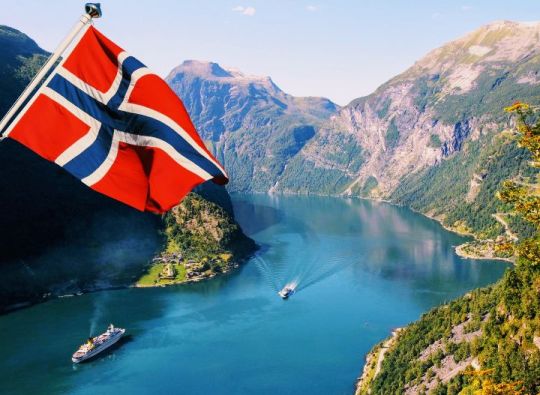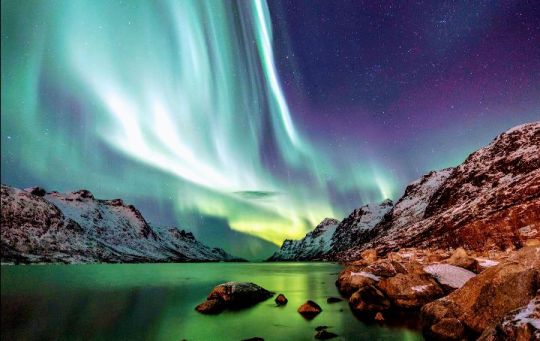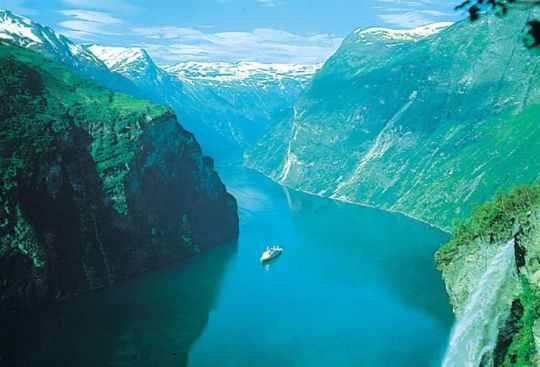Text
A Journey Through Norway

Norway, officially the Kingdom of Norway, is a nation in northern Europe's western Scandinavian Peninsula. Svalbard and Jan Mayen are included in the 148,449 sq mi (384,483 sq km) total area. Estimated population in 2023: 5,526,000. Norwegian capital. Although there are various ethnic minorities, including between 30,000 and 40,000 Sami (Lapps), the majority of the population is Norwegian. Norwegian and Sami are the official languages. Religion: Christianity (officially, Evangelical Lutheranism is the predominant form). currency: krone of Norway. Norway is one of the biggest nations in Europe. It is a hilly country with substantial plateau areas in the southwest and center. It has a developed economy mostly centered on services, petroleum and natural gas extraction, as well as light and heavy industries. Historically a fishing and logging country, it has considerably grown its mining and industrial operations since World War II. Literacy is almost universal.
Norway is a constitutional monarchy with a single parliamentary chamber; the king serves as the country's head of state, while the prime minister serves as the head of government. In the eleventh century, a number of principalities were combined to become the kingdom of Norway. From 1380 until 1814, when it was given to Sweden, it shared a ruler with Denmark. When the union with Sweden was broken up in 1905, Norway's economy expanded quickly. Despite the fact that its shipping industry was crucial to the war effort, it stayed neutral throughout the fight. Despite having declared itself neutral during World War II, German forces invaded and seized the area. Norway is a member of NATO and maintains a robust welfare system. In 1994, its citizens rejected joining the European Union.

Northern lights, Norway
The stark natural beauty of Norway has drawn tourists from all over the world. Other notable artists from the nation include playwright Henrik Ibsen, composer Edvard Grieg, painter Edvard Munch, writers Knut Hamsun and Sigrid Undset, and composer Edvard Grieg. Ibsen made the following observation about his own land and its reflective citizens: "The gorgeous, but severe, natural environment surrounding people up there in the north, the lonely, secluded life—the farms are miles apart—forces them to...become introspective and serious. At home every other person is a philosopher!"

Fjord, western Norway
Westward flowing rivers had a powerful erosive force. They carved out gorges and canyons that sliced deeply into the rugged coast, following fracture lines denoting weak spots in the Earth's crust. The terrain slopped more gently to the east, creating wider valleys. The magnificent U-shaped drowned fjords that now adorn the western coast of Norway were created by glaciers tonguing down the V-shaped valleys that were part of the landscape during repeated periods of glaciation in the Great Ice Age of the Quaternary Period (i.e., roughly the last 2.6 million years). Glacial action also transported enormous quantities of soil, gravel, and stone as far south as modern-day Denmark and northern Germany. The bedrock, which is exposed in roughly 40% of the area.
Climate of Norway
Although it occupies almost the same degrees of latitude as Alaska, Norway owes its warmer climate to the Norwegian Current (the northeastern extension of the Gulf Stream), which carries four to five million tons of tropical water per second into the surrounding seas. This current usually keeps the fjords from freezing, even in the Arctic Finnmark region. Even more important are the southerly air currents brought in above these warm waters, especially during the winter.
The mean annual temperature on the west coast is 45 °F (7 °C), or 54 °F (30 °C) above average for the latitude. In the Lofoten Islands, north of the Arctic Circle, the January mean is 43 °F (24 °C) above the world average for this latitude and one of the world’s greatest thermal anomalies.
Western Norway has a marine climate, with comparatively cool summers, mild winters, and nearly 90 inches (2,250 mm) of mean annual precipitation. Eastern Norway, sheltered by the mountains, has an inland climate with warm summers, cold winters, and less than 30 inches (760 mm) of mean annual precipitation.
Cultural institutions
Permanent theatres have been established in several cities, and the state traveling theatre, the Riksteatret, organizes tours throughout the country, giving as many as 1,200 performances annually. The Norwegian Opera, opened in 1959, receives state subsidies (as do most other theatres).
In addition to its National Art Gallery, Oslo opened a special museum in 1963 to honour Edvard Munch, credited as one of the founders of Expressionism and as Norway’s most famous painter. The Sonja Henie–Niels Onstad Art Centre, opened in 1968 near Oslo, contains modern art from throughout the world. Oslo is host to many other museums, including the Ibsen Centre, which honours the famed playwright, and the Resistance Museum, which documents Norway’s struggle against Nazi occupation during World War II. Outside Oslo, the Tromsø Museum’s collection records Sami heritage.
EXPENSES
The expenses for traveling to Norway from the Philippines can vary widely depending on factors like the duration of your stay, type of accommodation, activities, and personal preferences. Here are some estimated costs to consider:
Flights: The cost of round-trip flights can vary depending on the time of booking, airline, and travel dates. On average, you might spend between $800 to $1,500 or more.
Accommodation: Accommodation costs can vary from budget hostels (around $40-$100 per night) to mid-range hotels ($100-$250 per night) and luxury hotels ($250+ per night).
Food: Dining out in Norway can be expensive. Expect to spend around $20-$50 for a meal at a mid-range restaurant. You can save money by eating at more budget-friendly places or preparing your own meals.
Transportation: Local transportation in Norway, such as buses and trams, can be costly. A one-way ticket might cost around $3-$4. If you plan to travel between cities, train or bus tickets will vary in price.
Activities: The cost of activities and attractions can vary, but expect to spend on average $20-$50 per attraction or activity.
Travel insurance: Consider the cost of travel insurance to protect yourself during your trip.
Visa fees: If you need a visa to enter Norway, there may be associated fees.
Miscellaneous: Don't forget to budget for souvenirs, additional personal expenses, and unforeseen costs.
Overall, a moderate daily budget for a comfortable visit to Norway can range from $100 to $200 or more, depending on your spending habits and travel style. Be sure to plan and budget according to your specific travel plans and preferences.
ENJOY YOUR JOURNEY TO NORWAY
Reference:
Charles Jays, Gudmund Sandvik, Jorgen Weibull & The Editors of Encyclopedia Britannica (2023).
https://www.britannica.com/biography/Harald-I-king-of-Norway
# Travel # Create New Journey # Photography # aesthetic
4 notes
·
View notes